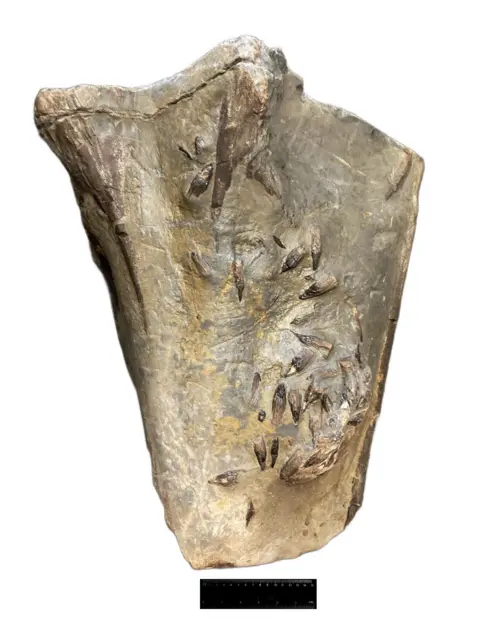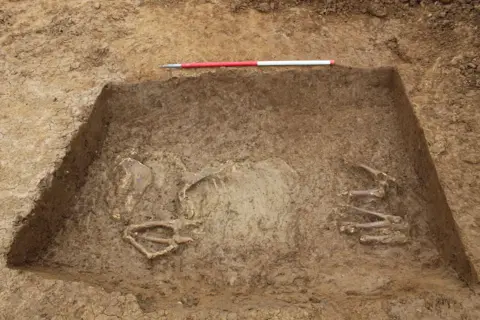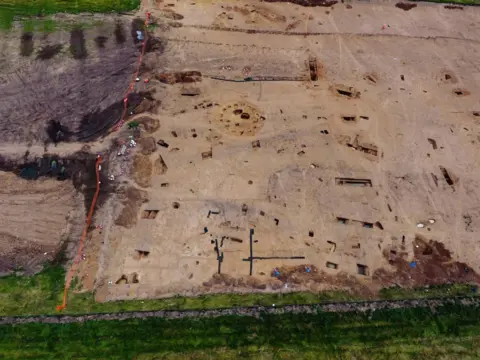Ancient ichthyosaur unearthed on road route

Excavations carried out to prepare for a new road through the Leicestershire countryside have revealed more than 100 million years of history.
The 4.3 mile (7km) long North and East sections of the Melton Mowbray Distributor Road will serve as a bypass for the town when construction is completed.
But before the surface of the new road is laid, teams from Leicestershire County Council contractors Galliford Try have uncovered the route’s past.
They have investigated 11 sites since 2023 to form an understanding of the past – and the council said a “long history of human activity” had been unearthed which is “locally and regionally important.”
 Archaeological Research Services
Archaeological Research ServicesThe earliest finds recorded by the team include the fossilised remains of part of a skull of an ichthyosaur, an extinct marine reptile, from at least 100 million years ago when Melton was submerged in a shallow ocean.
Archeologists say it dates from the Early Jurassic age.
 Archaeological Research Services
Archaeological Research ServicesThe sea predator was not a dinosaur, but a type of warm-blooded, air-breathing sea predator not unlike dolphins.
They could grow up to 25m long and lived between 250 million and 90 million years ago.
Their remains are normally found along coastlines and are sometimes exposed by the erosion of a cliff face.
A similar find was made in Rutland in 2021, although discovering such remains at inland areas is said to be unusual.
The council said it had also found evidence of humans living in the Melton area 8,000 years ago during the Middle Stone Age, or Mesolithic era.
It was a time when most people were hunter-gatherers, nomadic and used stone tools for hunting, cooking and crafting.
 Archaeological Research Services
Archaeological Research ServicesFlint artefacts including scrapers, piercers and even an arrowhead have been found scattered across the area in their hundreds, archaeologists said.
Some of these items were found in an ancient river channel, where it is thought humans were hunting animals such as deer.
They have also uncovered pits which are believed to date back to about 5,000 years ago.
The pits are believed to provide evidence of the first short-term settlements in the area.
Human burials have also been found dating back the Early Bronze age about 3,500 years ago.
But the archaeologists said people did not start to make their home in north Leicestershire until much later during the first century BC and first century AD, when four settlements were established in the area.
Iron Age pottery, animal bone and burnt stones have been found.
Extensive evidence has been found that the settlements were populated mainly by farmers, due to the amount of field boundaries, enclosures and agricultural structures in the area.
 Archaeological Research Services
Archaeological Research ServicesMixed farming is thought to have taken place at the pre-Melton farmsteads according to archeologists, who said they found a potential vineyard and “rare” evidence of root crops being grown in trenches by people living in Early Roman times.
The farms are believed to show the area making its first steps to becoming a market town as excess crops would probably have been grown to be sold, fuelling the local economy.
After the Romans left, the population decreased too with only short-term occupation in the Early Saxon period, said the council.
The settlements were lost under the farm fields surrounding Melton Mowbray during the late Medieval period.
The land then remained mostly unchanged over hundreds of years until the arrival of archaeologists in readiness for the construction of a bypass road.
Planning for the road began in 2017 and the main work got under way in May 2023.
The council said in its budget meeting in September the scheme was proving more expensive than expected.
The need to carry out the archaeological work was cited as one of the reasons for the overspend alongside poor weather leading to flooding and unstable ground.

The council had held an extra £11.6m in reserve for the £127.7m scheme, but has now said that that money would likely need to be used on the project, and that costs could go over that by a further £6m.
Officers said the authority was working with the contractor to attempt to reduce the overspend.










